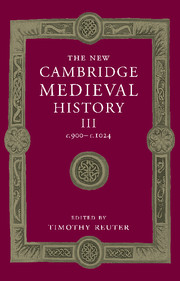Book contents
- Frontmatter
- 1 Introduction: reading the tenth century
- PART I GENERAL THEMES
- PART II POST-CAROLINGIAN EUROPE
- 9 The Ottonians as kings and emperors
- 10 Saxony and the Elbe Slavs in the tenth century
- 11 Bavaria in the tenth and early eleventh centuries
- 12 Lotharingia
- 13 Burgundy and Provence, 879–1032
- 14 The kingdom of Italy
- 15 West Francia: the kingdom
- 16 West Francia: the northern principalities
- 17 Western Francia: the southern principalities
- 18 England, c. 900–1016
- PART III NON-CAROLINGIAN EUROPE
- Appendix genealogical tables
- List of primary sources
- Bibliography of secondary works arranged by chapter
- Index
- Frontispiece
- Plate section
- Map 2: Archbishoprics and bishoprics in the early eleventh century
- Map 4: Germany
- Map 13: Byzantium in 1025
- References
14 - The kingdom of Italy
from PART II - POST-CAROLINGIAN EUROPE
Published online by Cambridge University Press: 28 March 2008
- Frontmatter
- 1 Introduction: reading the tenth century
- PART I GENERAL THEMES
- PART II POST-CAROLINGIAN EUROPE
- 9 The Ottonians as kings and emperors
- 10 Saxony and the Elbe Slavs in the tenth century
- 11 Bavaria in the tenth and early eleventh centuries
- 12 Lotharingia
- 13 Burgundy and Provence, 879–1032
- 14 The kingdom of Italy
- 15 West Francia: the kingdom
- 16 West Francia: the northern principalities
- 17 Western Francia: the southern principalities
- 18 England, c. 900–1016
- PART III NON-CAROLINGIAN EUROPE
- Appendix genealogical tables
- List of primary sources
- Bibliography of secondary works arranged by chapter
- Index
- Frontispiece
- Plate section
- Map 2: Archbishoprics and bishoprics in the early eleventh century
- Map 4: Germany
- Map 13: Byzantium in 1025
- References
Summary
the carolingian inheritance and the struggle for power
At Charles the Great’s deposition, the regnum Italiae, whose capital was Pavia, included north Italy from Piedmont to Friuli, Emilia as far as Modena, Tuscany, the Marches and the Abruzzi. From Romagna as far as central Italy the lands of the kingdom were interlinked with those of the patrimonium Petri, the temporal possessions ruled by the Roman church with varying degrees of success. From 888 to 923 Berengar, margrave of Friuli, was a major, though not the only dominant figure of the kingdom of Italy. Berengar’s coronation as king preceded that of his rival Wido, duke of Spoleto by a year. Wido had made unsuccessful attempts on the kingship in France and Burgundy, returning to Italy at the end of 888. Although his first battle with Berengar at Brescia was indecisive, he defeated him later at the River Trebbia and was crowned at Pavia in February 889.
The tumultuous immediate post-Carolingian period was dominated by the rivalry between Berengar and Wido, who were both typical products of a political transformation which had its roots in the hierarchical social order of the Frankish empire. Berengar’s family came from the lower Rhine and Wido’s from the Moselle region. Both were related to the Carolingians, and above all both governed large Carolingian territories by well-established dynastic right. Their ambitions were therefore the result of the status they had achieved within the previous administration and it was also natural that they should apply the dynastic-seigneurial power schemes which had already proven their worth in the marcher commands each held. Apart from Friuli and Spoleto-Camerino, there were two other large marches important enough to affect the balance of power in the kingdom: Tuscany and Ivrea (which included all of Piedmont and Liguria). The margrave of Tuscany, Adalbert, remained neutral during the first few years of the conflict between Berengar and Wido. The margrave of Ivrea, Anscar, had come to Italy from Burgundy in Wido’s train and so his family was initially instinctively pro-Wido.
Keywords
- Type
- Chapter
- Information
- The New Cambridge Medieval History , pp. 346 - 371Publisher: Cambridge University PressPrint publication year: 2000
References
- 2
- Cited by

